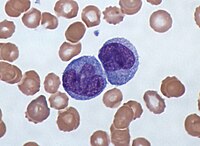
Photo from wikipedia
The activation phenotypes and functional changes in monocyte subsets during hepatitis C virus (HCV) elimination in HIV/HCV-coinfected patients were evaluated. Twenty-two HIV/HCV-coinfected patients on suppressive combination antiretroviral treatment (cART) achieving… Click to show full abstract
The activation phenotypes and functional changes in monocyte subsets during hepatitis C virus (HCV) elimination in HIV/HCV-coinfected patients were evaluated. Twenty-two HIV/HCV-coinfected patients on suppressive combination antiretroviral treatment (cART) achieving HCV elimination after direct-acting antiviral (DAA) therapy and 10 HIV-monoinfected patients were included. The activation phenotype (10 markers) and polyfunctionality (intracellular interleukin-1α [IL-1α], IL-1β, IL-6, IL-8, tumor necrosis factor alpha [TNF-α], and IL-10 production) in three monocyte subsets (classical, intermediate, and nonclassical) were evaluated by flow cytometry before and at the end of treatment. ABSTRACT The activation phenotypes and functional changes in monocyte subsets during hepatitis C virus (HCV) elimination in HIV/HCV-coinfected patients were evaluated. Twenty-two HIV/HCV-coinfected patients on suppressive combination antiretroviral treatment (cART) achieving HCV elimination after direct-acting antiviral (DAA) therapy and 10 HIV-monoinfected patients were included. The activation phenotype (10 markers) and polyfunctionality (intracellular interleukin-1α [IL-1α], IL-1β, IL-6, IL-8, tumor necrosis factor alpha [TNF-α], and IL-10 production) in three monocyte subsets (classical, intermediate, and nonclassical) were evaluated by flow cytometry before and at the end of treatment. Cell-associated HIV DNA levels were assayed by droplet digital PCR. After HCV clearance, there was a significant increase in classical monocyte and decreases in intermediate and nonclassical monocyte levels. The levels of the activation markers CD49d, CD40, and CX3CR1 were decreased after treatment in the monocyte subsets, reaching the levels in HIV-monoinfected patients. After lipopolysaccharide (LPS) stimulation, although polyfunctionality significantly decreased in intermediate and nonclassical monocytes, some combinations, such as the IL-1α− (IL-1α-negative) IL-1β− IL-6+ (IL-6-producing) IL-8− TNF-α− IL-10− combination, were remarkably increased at the end of treatment compared to the control group. Cell-associated HIV DNA levels correlated with activation markers before but not after treatment. HCV clearance after DAA treatment in patients on cART exerts an anti-inflammatory profile on monocyte subsets, activation phenotypes, and polyfunctionality. However, there is not a complete normalization compared with HIV-monoinfected patients.
Journal Title: Antimicrobial Agents and Chemotherapy
Year Published: 2020
Link to full text (if available)
Share on Social Media: Sign Up to like & get
recommendations!